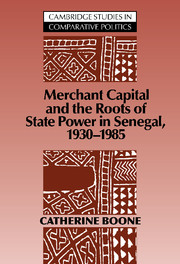Book contents
- Frontmatter
- Contents
- List of tables and figure
- Preface and acknowledgments
- Introduction
- 1 Capital and contingencies of postcolonial politics
- 2 The colonial market
- 3 Consolidation of a regime: Neocolonialism in the 1960s
- 4 Growth of Senegal's textile industry, 1960–1975
- 5 Reappropriation of the state: The 1970s
- 6 Demise of the Dakar textile industry
- Conclusion: States, capital, and capitalist states
- Appendix: Exchange rates
- References
- Index
4 - Growth of Senegal's textile industry, 1960–1975
Published online by Cambridge University Press: 13 October 2009
- Frontmatter
- Contents
- List of tables and figure
- Preface and acknowledgments
- Introduction
- 1 Capital and contingencies of postcolonial politics
- 2 The colonial market
- 3 Consolidation of a regime: Neocolonialism in the 1960s
- 4 Growth of Senegal's textile industry, 1960–1975
- 5 Reappropriation of the state: The 1970s
- 6 Demise of the Dakar textile industry
- Conclusion: States, capital, and capitalist states
- Appendix: Exchange rates
- References
- Index
Summary
In Senegal, “the costly mistake of trying to work against the maisons de commerce was not repeated. After 1960, the industrial–commercial combinations seemed to work the best. … Competition had corrosive effects on business.”
Reminiscences of a textile manufacturer, 1985During the colonial period, the largest maisons de commerce imported (mostly) French textile goods to the AOF by way of the port of Dakar. In the early 1950s, this link in the chain of merchant capital's operations was threatened. A few industrialists tried to cut the colonial trading houses out of the distribution chain by jumping the tax and tariff barrier, producing textile goods in Dakar, and selling these goods directly to dozens of local traders. The effort to end-run merchant capital failed. Through dumping and price wars, the trading companies succeeded in breaking the independence of the Dakar textile manufacturers. In the late 1950s, the maisons de commerce began to absorb the local factories into their sphere of commercial control.
This process would continue unabated after independence. By the mid-1960s, local production, importation, and the wholesale distribution of staple textile goods lay in the hands of a few industries and large commercial houses. These firms worked in concert, dividing the market amongst themselves, setting prices, and calibrating the flow of imports and made-in-Senegal goods onto the local market.
- Type
- Chapter
- Information
- Merchant Capital and the Roots of State Power in Senegal1930–1985, pp. 131 - 164Publisher: Cambridge University PressPrint publication year: 1992



